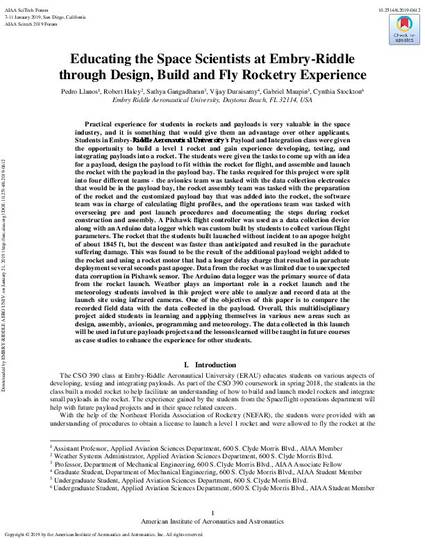
Presentation
Educating the Space Scientists at Embry-Riddle through Design, Build and Fly Rocketry Experience
AIAA Scitech 2019 Forum, AIAA SciTech Forum (AIAA 2019-0612)
(2019)
Abstract
Practical experience for students in rockets and payloads is very valuable in the space industry, and it is something that would give them an advantage over other applicants. Students in Embry-Riddle Aeronautical University’s Payload and Integration class were given the opportunity to build a level 1 rocket and gain experience developing, testing, and integrating payloads into a rocket. The students were given the tasks to come up with an idea for a payload, design the payload to fit within the rocket for flight, and assemble and launch the rocket with the payload in the payload bay. The tasks required for this project were split into four different teams - the avionics team was tasked with the data collection electronics that would be in the payload bay, the rocket assembly team was tasked with the preparation of the rocket and the customized payload bay that was added into the rocket, the software team was in charge of calculating flight profiles, and the operations team was tasked with overseeing pre and post launch procedures and documenting the steps during rocket construction and assembly. A Pixhawk flight controller was used as a data collection device along with an Arduino data logger which was custom built by students to collect various flight parameters. The rocket that the students built launched without incident to an apogee height of about 1845 ft, but the descent was faster than anticipated and resulted in the parachute suffering damage. This was found to be the result of the additional payload weight added to the rocket and using a rocket motor that had a longer delay charge that resulted in parachute deployment several seconds past apogee. Data from the rocket was limited due to unexpected data corruption in Pixhawk sensor. The Arduino data logger was the primary source of data from the rocket launch. Weather plays an important role in a rocket launch and the meteorology students involved in this project were able to analyze and record data at the launch site using infrared cameras. One of the objectives of this paper is to compare the recorded field data with the data collected in the payload. Overall, this multidisciplinary project aided students in learning and applying themselves in various new areas such as design, assembly, avionics, programming and meteorology. The data collected in this launch will be used in future payloads projects and the lessons learned will be taught in future courses as case studies to enhance the experience for other students.
Keywords
- Payload,
- Rocketry,
- Education,
- Spaceflight Operations,
- Engineering,
- Suborbital
Disciplines
Publication Date
Winter January 7, 2019
DOI
10.2514/6.2019-0612
Citation Information
Pedro Llanos, Robert E. Haley and Sathya Gangadharan. "Educating the Space Scientists at Embry-Riddle through Design, Build and Fly Rocketry Experience" AIAA Scitech 2019 Forum, AIAA SciTech Forum (AIAA 2019-0612) (2019) Available at: http://works.bepress.com/pedro_j_llanos/36/
